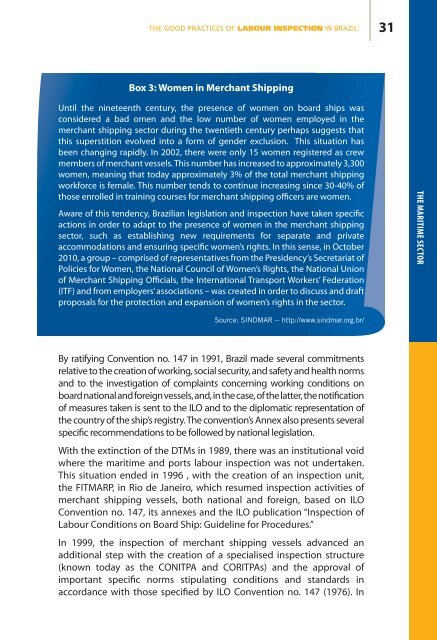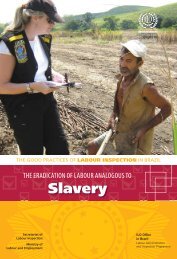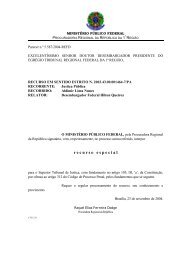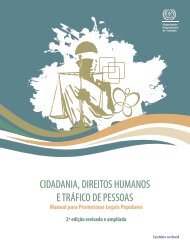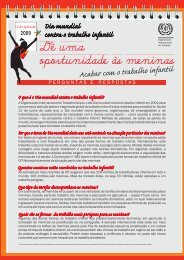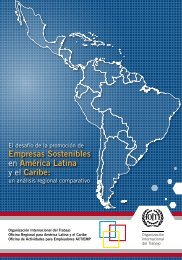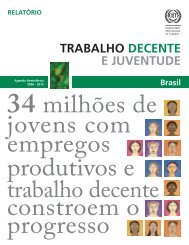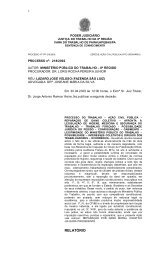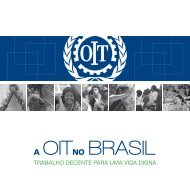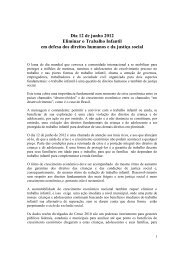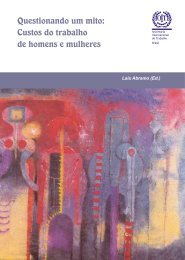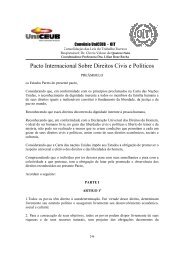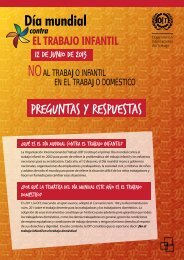The Maritime Sector
The Maritime Sector
The Maritime Sector
You also want an ePaper? Increase the reach of your titles
YUMPU automatically turns print PDFs into web optimized ePapers that Google loves.
THE GOOD PRACTICES OF LABOUR INSPECTION IN BRAZIL: 31Box 3: Women in Merchant ShippingUntil the nineteenth century, the presence of women on board ships wasconsidered a bad omen and the low number of women employed in themerchant shipping sector during the twentieth century perhaps suggests thatthis superstition evolved into a form of gender exclusion. This situation hasbeen changing rapidly. In 2002, there were only 15 women registered as crewmembers of merchant vessels. This number has increased to approximately 3,300women, meaning that today approximately 3% of the total merchant shippingworkforce is female. This number tends to continue increasing since 30-40% ofthose enrolled in training courses for merchant shipping officers are women.Aware of this tendency, Brazilian legislation and inspection have taken specificactions in order to adapt to the presence of women in the merchant shippingsector, such as establishing new requirements for separate and privateaccommodations and ensuring specific women’s rights. In this sense, in October2010, a group – comprised of representatives from the Presidency’s Secretariat ofPolicies for Women, the National Council of Women’s Rights, the National Unionof Merchant Shipping Officials, the International Transport Workers’ Federation(ITF) and from employers’ associations – was created in order to discuss and draftproposals for the protection and expansion of women’s rights in the sector.THE MARITIME SECTORSource: SINDMAR -- http://www.sindmar.org.br/By ratifying Convention no. 147 in 1991, Brazil made several commitmentsrelative to the creation of working, social security, and safety and health normsand to the investigation of complaints concerning working conditions onboard national and foreign vessels, and, in the case, of the latter, the notificationof measures taken is sent to the ILO and to the diplomatic representation ofthe country of the ship’s registry. <strong>The</strong> convention’s Annex also presents severalspecific recommendations to be followed by national legislation.With the extinction of the DTMs in 1989, there was an institutional voidwhere the maritime and ports labour inspection was not undertaken.This situation ended in 1996 , with the creation of an inspection unit,the FITMARP, in Rio de Janeiro, which resumed inspection activities ofmerchant shipping vessels, both national and foreign, based on ILOConvention no. 147, its annexes and the ILO publication “Inspection ofLabour Conditions on Board Ship: Guideline for Procedures.”In 1999, the inspection of merchant shipping vessels advanced anadditional step with the creation of a specialised inspection structure(known today as the CONITPA and CORITPAs) and the approval ofimportant specific norms stipulating conditions and standards inaccordance with those specified by ILO Convention no. 147 (1976). In


